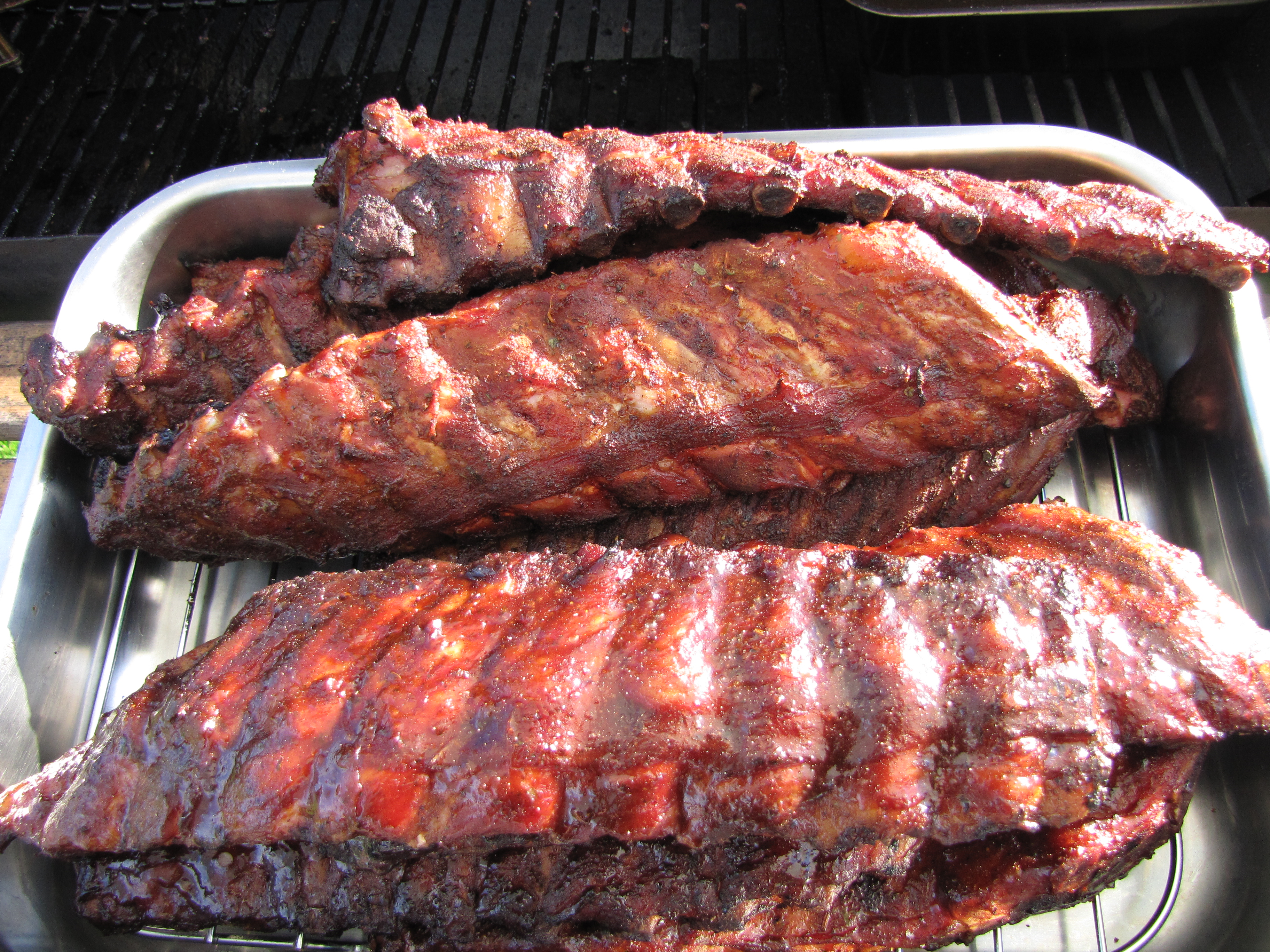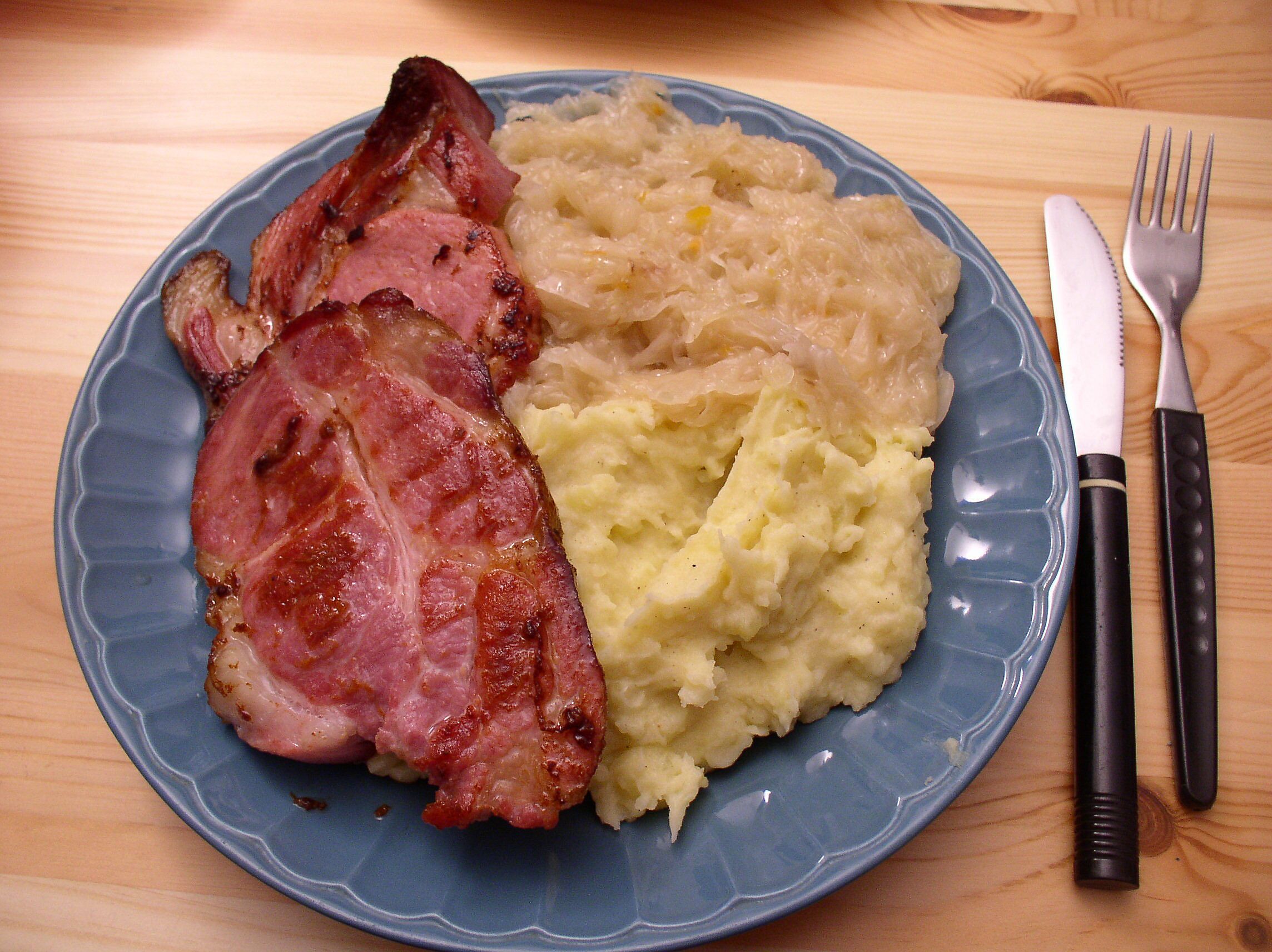|
Frankfurter Rippchen
(Frankfurter) ''Rippchen mit Kraut'' (hot cured cutlet with sauerkraut) is a traditional dish served in and around Frankfurt am Main, Germany.Peter BadenhopFrankfurter Gerichte : Fünf Spezialitäten, die man probiert haben sollte(five inevitable dishes of Frankfurt) in: Frankfurter Allgemeine Zeitung dated 25. August 2021 It consists of cured pork cutlets, slowly heated in sauerkraut or meat broth, and usually served with sauerkraut, mashed potatoes and yellow mustard. Apfelwein (German cider) is normally consumed alongside Rippchen. The Rippchen are similar in appearance and texture to Kassler, but slightly milder in flavour, since they are only cured, rather than smoked. See also *Sachsenhausen (Frankfurt am Main) * List of pork dishes This is a list of notable pork dishes. Pork is the culinary name for meat from the domestic pig (''Sus domesticus''). It is one of the most commonly consumed meats worldwide,Raloff, JanetFood for Thought: Global Food Trends Science News O ... [...More Info...] [...Related Items...] OR: [Wikipedia] [Google] [Baidu] |
Mustard (condiment)
Mustard is a condiment made from the mustard seed, seeds of a mustard plant (white/yellow mustard, ''white mustard, Sinapis alba''; brown mustard, ''Brassica juncea''; or black mustard, ''Brassica nigra''). The whole, ground, cracked, or bruised mustard seeds are mixed with water, vinegar, lemon juice, wine, or other liquids, salt, and often other flavorings and spices, to create a paste or sauce ranging in color from bright yellow to dark brown. The seed itself has a strong, pungent, and somewhat bitter taste. The taste of mustard condiments ranges from sweet to spicy. Mustard is commonly paired with meats, vegetables and cheeses, especially as a condiment for sandwiches, hamburgers, and hot dogs. It is also used as an ingredient in many salad dressing, dressings, Glaze (cooking technique), glazes, sauces, soups, and marinades. As a cream or as individual seeds, mustard is used as a condiment in the cuisine of Indian cuisine, India and Bangladeshi cuisine, Bangladesh, the Medi ... [...More Info...] [...Related Items...] OR: [Wikipedia] [Google] [Baidu] |
Pork Dishes
Pork is the culinary name for the meat of the domestic pig (''Sus domesticus''). It is the most commonly consumed meat worldwide, with evidence of pig husbandry dating back to 5000 BCE. Pork is eaten both freshly cooked and preserved; curing extends the shelf life of pork products. Ham, gammon, bacon, and sausage are examples of preserved pork. Charcuterie is the branch of cooking devoted to prepared meat products, many from pork. Pork is the most popular meat in the Western world, particularly in Central Europe. It is also very popular in East and Southeast Asia (Mainland Southeast Asia, Philippines, Singapore, and East Timor). The meat is highly prized in Asian cuisines, especially in Mainland China, for its fat content and texture. Some religions and cultures prohibit pork consumption, notably Islam and Judaism. History Pigs were domesticated in Mesopotamia around 13,000 BC. Charcuterie is the branch of cooking devoted to prepared meat products such as bacon ... [...More Info...] [...Related Items...] OR: [Wikipedia] [Google] [Baidu] |
List Of Pork Dishes
This is a list of notable pork dishes. Pork is the culinary name for meat from the domestic pig (''Sus domesticus''). It is one of the most commonly consumed meats worldwide,Raloff, JanetFood for Thought: Global Food Trends Science News Online. May 31, 2003. with evidence of pig husbandry dating back to 5000 BC. Pork is eaten both freshly cooked and preserved. The consumption of pork is prohibited in Judaism, Islam, and some Christian denominations such as Seventh-day Adventism. Fresh pork may contain trichinosis, a parasitic disease caused by eating raw or undercooked pork or wild game infected with the larvae of a species of roundworm ''Trichinella spiralis'', commonly called the trichina worm. In the United States, the U.S. Department of Agriculture recommends cooking ground pork, that is obtained from pig carcasses, to an internal temperature of 160 °F, followed by a 3-minute rest, and cooking whole cuts to a minimum internal temperature of 145 °F, also followed ... [...More Info...] [...Related Items...] OR: [Wikipedia] [Google] [Baidu] |
Sachsenhausen (Frankfurt Am Main)
Sachsenhausen-Nord and Sachsenhausen-Süd are two quarters of Frankfurt am Main, Germany. The division into a northern and a southern part is mostly for administrative purposes as Sachsenhausen is generally considered a single entity. Both city districts are part of the ''Ortsbezirk Süd''. As a whole, Sachsenhausen is the largest district by population and area in Frankfurt. It is located south of the Main river and borders the districts of Niederrad and Flughafen to the west and Oberrad to the east. Sachsenhausen-Süd is mostly comprised by the Frankfurt City Forest. Sachsenhausen was founded as Frankfurt's bridgehead in the 12th century. The oldest documents point to the year 1193. Unlike Frankfurt's own historic city center, which burned to the ground after British bombing in 1944, Sachsenhausen's old town is partly preserved. The Frankfurt youth hostel is located on its riverside. The population of Sachsenhausen is 55,422. The River Main embankment hosts the city's la ... [...More Info...] [...Related Items...] OR: [Wikipedia] [Google] [Baidu] |
Smoked Meat
Smoked meat is the result of a method of preparing red meat, white meat, and seafood which originated in the Paleolithic Era. Smoking adds flavor, improves the appearance of meat through the Maillard reaction, and when combined with curing it preserves the meat. When meat is cured then cold-smoked, the smoke adds phenols and other chemicals that have an antimicrobial effect on the meat. Hot smoking has less impact on preservation and is primarily used for taste and to slow-cook the meat. Interest in barbecue and smoking is on the rise worldwide. Smoking with wood Generally meat is smoked using hardwood or wood pellets made from hardwood; softwood is not recommended due to increased PAH from the resin. Wood smoke adds flavor, aroma, and helps with preservation. There are two types of smoking: cold smoking generally occurs below and has more preservative value. Hot smoking generally occurs above . Most woods are seasoned and not used green. There are many types of wood used ... [...More Info...] [...Related Items...] OR: [Wikipedia] [Google] [Baidu] |
Kassler
Kassler or Kasseler in German cuisine is the name given to a cured and slightly smoked cut of pork similar to gammon. It can be either hot or cold smoked. Pork necks and loins are the most often used cuts although ribs, shoulders and bellies can also be used. It is often served either with sauerkraut and mashed potatoes or with kale and roasted potatoes. In addition to pork, chicken prepared 'Kasseler' style is available at some butchers. It is unclear where the name comes from. It is often said that the name derived from a Berlin-based butcher called Cassel who prepared the cut in the late 19th century. However, records of the town's inhabitants show that in the 19th century no butcher named Cassel or Kassel was living in Berlin. Likewise, it is not possible to prove that Kasseler comes from the German town Kassel. In Finland, pork neck of any type is called ''kassler''. A similar dish, ''hamburgerryg'', is eaten in Denmark. In this variation the meat is boiled. It is often ... [...More Info...] [...Related Items...] OR: [Wikipedia] [Google] [Baidu] |
Apfelwein
''Apfelwein'' ( German, 'apple wine'), or ''Viez'' ( Moselfranken, Saarland, Trier, ''vice'') or ''Most'' ( Austria, Switzerland, South Germany, ''must'') are German words for cider. It is made from a mix of sour tasting apples, such as "Bohnapfel" or "Speierling", respectively. It has an alcohol content of 4.8–7.0% and a tart, sour taste. ''Apfelwein'' is also regionally known as ''Ebbelwoi'', ''Äppler'', ''Stöffsche'', ''Apfelmost'' (apple must), ''Viez'' (from Latin ''vice'', the second or substitute wine), and ''saurer Most'' (sour must, ''Süßmost'' or sweet must is essentially apple juice). Instead of the name ''Äppler'', restaurants and smaller manufacturers may instead call the beverage ''Schoppen'' or ''Schoppe'', which actually refers to the measure of the glass. In the Frankfurt area, berries from the service tree (''Sorbus domestica'') may be added in small quantities to increase astringency, in which case the specific type of ''Apfelwein'' is called ''Spe ... [...More Info...] [...Related Items...] OR: [Wikipedia] [Google] [Baidu] |
Mashed Potatoes
Mashed potato or mashed potatoes (American and Canadian English), colloquially known as mash (British English), is a dish made by mashing boiled or steamed potatoes, usually with added milk, butter, salt and pepper. It is generally served as a side dish to meat or vegetables. Roughly mashed potatoes are sometimes called smashed potatoes. Dehydrated instant mashed potatoes and frozen mashed potatoes are available. Mashed potatoes are an ingredient in other dishes, such as dumplings and gnocchi. Ingredients Most authors recommend the use of "floury" potatoes with a high ratio of amylose in their starch to achieve a fluffy, creamy consistency and appearance. The best-known floury varieties are King Edward, golden wonder, and red rascal in Britain and the Russet in North America. However, some recipes use "waxy" potatoes containing more amylopectin in their starch for a different texture or look; for instance, one pounded mashed potato dish from Yunnan cuisine (in southwestern C ... [...More Info...] [...Related Items...] OR: [Wikipedia] [Google] [Baidu] |
Curing (food Preservation)
Curing is any of various food preservation and flavoring processes of foods such as meat, fish and vegetables, by the addition of salt, with the aim of drawing moisture out of the food by the process of osmosis. Because curing increases the solute concentration in the food and hence decreases its water potential, the food becomes inhospitable for the microbe growth that causes food spoilage. Curing can be traced back to antiquity, and was the primary method of preserving meat and fish until the late 19th century. Dehydration was the earliest form of food curing. Many curing processes also involve smoking, spicing, cooking, or the addition of combinations of sugar, nitrate, and nitrite."Historical Origins of Food Preservation." [...More Info...] [...Related Items...] OR: [Wikipedia] [Google] [Baidu] |
Broth
Broth, also known as bouillon (), is a savory liquid made of water in which meat, fish or vegetables have been simmered for a short period of time. It can be eaten alone, but it is most commonly used to prepare other dishes, such as soups, gravies, and sauces. Commercially prepared liquid broths are available, typically chicken, beef, fish, and vegetable varieties. Dehydrated broth in the form of bouillon cubes were commercialized beginning in the early 20th century. Broths have been used as a nutrition source for the sick in Great Britain since at least the early 1700s, such as for dysentery patients. Stock versus broth Many cooks and food writers use the terms ''broth'' and ''stock'' interchangeably. In 1974, James Beard wrote that stock, broth, and bouillon "are all the same thing". While many draw a distinction between stock and broth, the details of the distinction often differ. One possibility is that stocks are made primarily from animal bones, as opposed to mea ... [...More Info...] [...Related Items...] OR: [Wikipedia] [Google] [Baidu] |
Pork
Pork is the culinary name for the meat of the domestic pig (''Sus domesticus''). It is the most commonly consumed meat worldwide, with evidence of pig husbandry dating back to 5000 BCE. Pork is eaten both freshly cooked and preserved; curing extends the shelf life of pork products. Ham, gammon, bacon, and sausage are examples of preserved pork. Charcuterie is the branch of cooking devoted to prepared meat products, many from pork. Pork is the most popular meat in the Western world, particularly in Central Europe. It is also very popular in East and Southeast Asia ( Mainland Southeast Asia, Philippines, Singapore, and East Timor). The meat is highly prized in Asian cuisines, especially in Mainland China, for its fat content and texture. Some religions and cultures prohibit pork consumption, notably Islam and Judaism. History Pigs were domesticated in Mesopotamia around 13,000 BC. Charcuterie is the branch of cooking devoted to prepared meat products such as ... [...More Info...] [...Related Items...] OR: [Wikipedia] [Google] [Baidu] |






